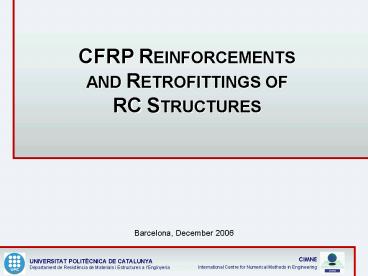CFRP REINFORCEMENTS AND RETROFITTINGS OF RC STRUCTURES - PowerPoint PPT Presentation
1 / 12
Title: CFRP REINFORCEMENTS AND RETROFITTINGS OF RC STRUCTURES
1
CFRP REINFORCEMENTS AND RETROFITTINGS OF RC
STRUCTURES
Barcelona, December 2006
2
Introduction
- Structural reinforcement and retrofitting of RC
structures using CFRP has become one of the main
applications of composites in civil engineering. - The finite element code PLCD is used to develop
structural simulations of CFRP reinforcements and
retrofittings of RC structures. These simulations
allow - Obtain a better understanding of the strength
mechanisms of CFRP reinforcements. - Develop different simulations to obtain the
better CFRP configuration for the structure to be
reinforced.
Three different simulations are herein
presented 1. Beam reinforcement ? Used to
validate the code 2. Beam retrofitting ? Used
to compare structural performance 3. Framed
structure ? In which different CFRP
configurations are tested to obtain which one
offers a better performance
CFRP Reinforcements and Retrofittings of RC
Structures
3
Code Validation Beam Reinforcement
Geometry and reinforcements of the beam used to
validate the code Spadea et al. (1998)
Component materials used to simulate the beam
CFRP Reinforcements and Retrofittings of RC
Structures CODE VALIDATION
4
Finite Element Models Developed
- Two different models have been developed
- Sp3D-R0 Beam without CFRP reinforcement
- Sp3D-R1 Beam with CFRP reinforcement
- Finite element discretization and composite
materials defined
CFRP Reinforcements and Retrofittings of RC
Structures CODE VALIDATION
5
Results Obtained Numerical vs. Experimental
The results obtained are compared with the
experimental ones obtained by Spadea et al.
Comparison is done with a capacity curve (force
applied vs. displacement of the beam where the
force is applied). Results show the ability of
the code to simulate these sort of reinforcements.
Agreement is also found in the failure modes.
Experimental failure modes are No Reinforced
Tension steel yielding and concrete
crushing Reiniforced Sudden and total loss of
load capacity explosive debonding of
CFRP Numerical failure modes
Sp3D-R0 model All concrete is damaged Steel
has yield
Sp3D-R1 model The most damaged section is as the
non-reinforced one
Explosive debounding does not occur because the
model supposes perfect bonding of the CFRP
CFRP Reinforcements and Retrofittings of RC
Structures CODE VALIDATION
6
Results Obtained Materials Performance
CFRP REINFORCEMENT Matrix material has reached
its yielding value and is damaged Fibre material
is steel under elastic conditions (stress lt 30
of its maximum value)
SERIAL/PARALLEL MIXING THEORY PERFORMANCE The
performance of the S/P mixing theory is studied
with the steel stirrups. Transversal stresses in
transversal stirrups must be larger than
longitudinal stresses (which must be the same
obtained in concrete)
Long Stress in Steel
Long Stress in Concrete
CFRP Reinforcements and Retrofittings of RC
Structures CODE VALIDATION
7
Retrofitting Simulation
The retrofitting simulation has been done with
the beam used for the code validation.
- Two different models are developed, depending on
when the CFRP is applied - Sp3D-Rt2 CFRP is applied when damage starts in
concrete - Sp3D-Rt3 CFRP is applied when damage starts in
steel
- Structural stiffness does not depend on when the
structure is retrofitted - Retrofit a structure implies that, when the CFRP
reinforcement starts collaborating, the structure
has a deformation and damage larger than if it
had been reinforced from the beginning. Damage
reduces the load capacity of the beam while
deformation can make the serviceability state
unacceptable. - Load of 25kN ? Deformation is 45 larger in
Sp3D-Rt3 model than in Sp3D-Rt2.
CFRP Reinforcements and Retrofittings of RC
Structures RETROFITTING SIMULATION
8
Framed Structure Simulation
GEOMETRY AND REINFORCEMENTS
2D and 3D simulations 3 different models,
according to the CFRP reinforcement applied 1.
No reinforcement (noR) 2. Upper and Lower reinf.
(R) 3. Upper, Lower and Lateral reinf. (LR)
CFRP Reinforcements and Retrofittings of RC
Structures FRAMED STRUCTURE SIMULATION
9
Composite Materials Definition
CFRP Reinforcements and Retrofittings of RC
Structures FRAMED STRUCTURE SIMULATION
10
Results Obtained 2D models
Structural performance obtained with each
reinforcement
- Results obtained with Upper and Lower
reinforcements (2DF-R) are very similar to the
ones obtained when no reinforcement is applied
(2DF-noR) - The formation of plastic hinge appears for a
load 25 larger if the Lateral reinforcement
(2DF-LR) Is applied to the structure.
Failure criteria obtained with each reinforcement
- Failure criteria in 2DF-R model is nearly the
same than in 2DF-noR model. - The plastic hinge appears afterwards in 2DF-LR
model because it is displaced form the concrete
joint to a section where no reinforcement is
applied.
CFRP Reinforcements and Retrofittings of RC
Structures FRAMED STRUCTURE SIMULATION
11
Results Obtained 3D models
Structural performance obtained with each
reinforcement
- The behaviour of the models is similar to the
one found in 2D simulation - Models are stiffer as concrete confinement by
steel stirrups is better represented - Plastic hinge in 3DF-R model appears before than
in 3DF-noR model. This is because the failure
criteria
Failure criteria obtained with each reinforcement
No reinforced model (3DF-noR)
Upper and Lower reinforced model (3DF-R)
Plastic hinge occurs before in 3DF-R model
because the section where it appears is closer to
the section where damage starts
CFRP Reinforcements and Retrofittings of RC
Structures FRAMED STRUCTURE SIMULATION
12
Results Obtained 3D models
When the failure criteria in the Lateral
reinforced model is studied (3DF-LR), it shows
that 2D simulations can provide wrong results in
some cases
Figure - a - show a behaviour similar to the one
obtained with 2D models Damage is larger in the
section where no reinforcement is applied.
However, an internal view shows that the crack
still appears in the frame joint. This can be
seen better in a zenith view.
CFRP Reinforcements and Retrofittings of RC
Structures FRAMED STRUCTURE SIMULATION































